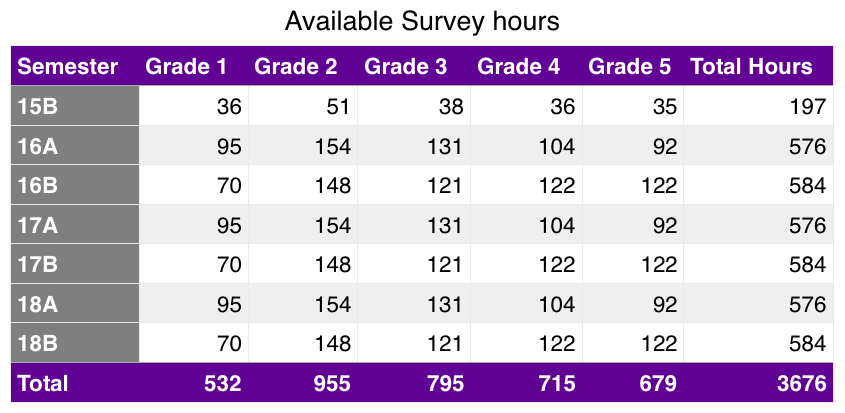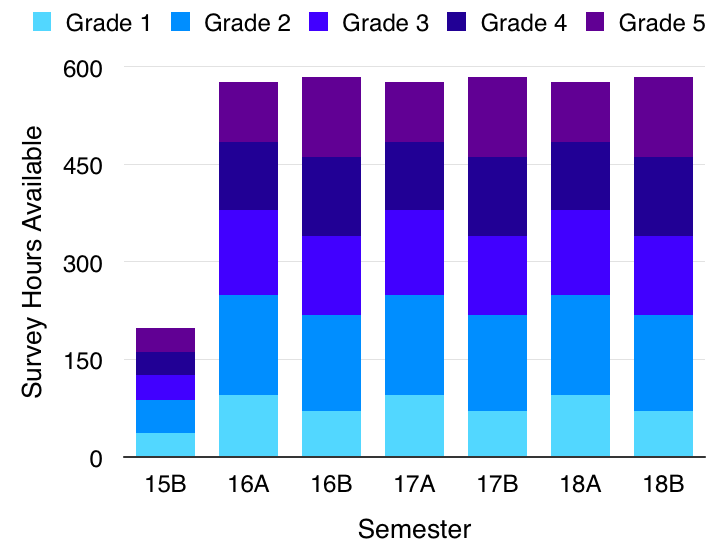The East Asian Observatory announces the opening of a Call for Survey Proposals for the James Clerk Maxwell Telescope.
Call for JCMT Survey proposals
Up to 3600 hours of time to be awarded between: December 2015 and January 2019
The closing date for submissions is
Friday July 31st 2015
15:00 Hawaiian Standard Time
Contents
Overview
The East Asian Observatory announces the opening of a Call for Survey Proposals for the James Clerk Maxwell Telescope. Surveys are defined by the observatory as projects which require significant amounts (> 200 hours) of observing time, require more than a single semester to complete and that take full advantage of the JCMT instrumentational capabilities to address multiple important scientific questions.
The continued and growing impact of the JCMT Legacy Surveys, initiated in 2007 and completed in early 2015, has been a strong incentive to solicit new Surveys with the JCMT under EAO management.
Eligibility
Submissions will be accepted from scientists in any of the East Asian Observatory regions (Japan, China, Taiwan and the South Korea) and participating JCMT regions (UK and Canada). Any scientist from these regions is eligible to participate at any level (PI or co-I) in a survey proposal. Collaborations are strongly encouraged and subject to the requirements detailed below (see Survey Definitions and Requirements). Multiple PIs are allowed for survey proposals. Following the approval of a survey, admission to a survey collaboration will be opened to scientists from all participating regions until the start of survey observing. Membership management following that date will be at the discretion of the individual survey management team. The JCMT will provide assistance in maintaining survey sign-up and membership distribution lists and webpages as required.
Survey Definitions and Requirements
Successful JCMT survey proposals will:
-
be self-contained, and address a number of important scientific questions;
-
generally request a minimum of 200hrs;
-
use SCUBA-2 (alone or with its FTS-2/POL-2 modules) and/or HARP-B (alone, or with polarimetry via Rover) and/or RxA.
-
demonstrate legacy value, fully justifying the need for survey status, rather than that of a conventional TAC proposal;
-
include investigators from at least two regions, including at least one JCMT partner region (UK or Canada) and at least one EAO region (China, Taiwan, Japan, South Korea). Collaborations between more than two regions are strongly encouraged – the assessment process will consider the degree to which the proposals represent the interests of all the relevant communities;
-
include a viable management plan (e.g. membership rules), and publication plan;
-
identify and explain any link(s) to other survey(s);
Proposal Requirements
The proposal should:
- address all of the requirements listed above
- list all PI(s), co-Is and their regional affiliations
- include both a scientific and technical case
- be submitted in pdf form with a total length of no more than 15 pages
- in the technical case, the proposal must utilise the available integration time calculators provided by the observatory to justify their time request (see Calculating Integration Times below)
- specify the weather conditions (read opacity) that it requires or can tolerate. The amount of time available per weather/opacity band varies through the year
- be submitted via email to this address, by July 31st, 2015 to receive full consideration. Any questions regarding proposals should also be directed to this address or to the help desk
- NEW: Source lists – if the proposal requires an extensive list of sources, this can be included as a separate file that will not be considered part of the page count.
Time Available
EAO intends to allocate up to half of the available science time between December 2015 and the end of January 2019 to survey proposals that meet the required goals. The JCMT normally operates a 12-hour night, running from approximately 7:30pm to 7:30am HST. Table A and Table B show source transit times during (roughly) the first and seconds halves of the year.
The table below shows the estimated distribution of available science time for surveys. This constitutes 50% of the total available time – the other 50% will remain available for P.I. projects. The hours are broken down in approximate distribution as a function of weather grade. Weather grade percentages per semester are derived from long-term averages (2003-2015) as determined by the CSO radiometer and 183GHz Water Vapor Meter (WVM) at JCMT. The figure provides the same hourly distributions, in graphical form.
Survey Review and Proprietary Periods
A Survey Review Committee will assess all proposals during August and September 2015, and provide recommendations for survey time awards to the JCMT Board. The JCMT Board will determine the final allocations and award announcements will be made to successful P.I.s in October 2015. At this time, sign-up for membership to successful surveys will be announced and supported by the JCMT. Surveys will be asked to prepare for submission of observations to the observatory which will commence in December 2015.
Survey data will have the same proprietary period as P.I. data collected at the JCMT, consisting of a full year following completion of the semester in which the data was taken. There will be a mid-survey review to assess the performance of the surveys in progress. Survey proposals are asked to include a description of their intended publication plan, taking the proprietary period and review into account.
Survey Timeline
| Survey Call Opens | May 15 2015 |
| Survey Call deadline | July 31 2015 |
| Survey Review | August-September 2015 |
| Survey Awards announced | October 2015 |
| Survey sign-up | October 2015 – 1 December 2015 |
| Survey start | 1 December 2015 |
| Survey completion | 1 January 2019 |
Resources for Survey Planning
The observatory is aware that the timeline for preparation of survey submissions is short. For this reason EAO/JCMT will provide assistance to scientists wishing to communicate and collaborate in preparing high-quality proposals.
Available Instrumentation and Observing Modes
The current status and availability of the JCMT instrument suite is here.
Continuum Receivers –
- SCUBA-2 (simultaneous 450µm & 850µm imaging)
Heterodyne Receivers – General overview
Heterodyne Backend
- ACSIS – Available bandwidths, spectral resolutions and backend modes.
- The ACSIS correlating spectrometer is a highly flexible backend; it was designed to work with HARP, but it works with all our heterodyne receivers.
Several modes of heterodyne observing and several switching schemes are supported.
See also the Instrumentation summary from the January Workshops
Pol-2/FTS-2
The SCUBA-2 Polarimeter (Pol-2) and Fourier Transform Spectrometer (FTS-2) are not yet fully commissioned at the JCMT. However, this commissioning is successfully ongoing at the observatory and it is hoped to be complete in time for at least the bulk of the survey observing time. For this reason, these instruments are put forward as available for consideration in survey proposal science. Estimates of sensitivities with these instruments will be provided here shortly, in order to facilitate integration time calculations for survey proposals that desire their use.
Calculating Integration Times
Integration time calculators or formulae are available, for
They should be used to calculate the integration time needed to reach a given RMS per channel or beam or output-map pixel as a function of receiver, frequency, observing mode, elevation and sky opacity.
The JCMT Observing Tool (JCMTOT) gives equivalent results for all instruments.
- Overheads for pointing, focussing, and calibrations should not be added to the time request. These activities will be accounted for separately. Calibration observations (eg. focus, pointing, flux calibrators) and other unavoidable overheads (eg receiver tuning) are no longer charged to science projects and instead are charged to an observatory accounting code. There is therefore no need for applicants to provide calibration overhead estimates in their proposals.The observatory will perform regular and appropriate calibration observations to ensure that all science data obtained are sensibly calibrated.
- Spectroscopically, this involves observations of one of our Spectral Line Standards at one of about ten different standard line frequencies . If your programme frequency is one of these, then you’re decidely in luck. In any case, the calibration allows you to assess the performance of the instrument. We will perform such an observation at least once per programme unless a previous calibration is still appropriate, and more often if circumstances change or if more than a couple of hours pass.
- For continuum work, continuum calibrators will be observed at both operational wavelengths of SCUBA-2 (450µm, 850µm) at appropriate times and airmass to meet the general needs of the science programmes.
If a proposal demands more unusual or more frequent calibrations then this needs to be clearly stated in the proposal and the time for these calibrations requested explicitly. If you have queries about what our default calibrations might be or what extra overheads are generated by your calibration requirements please get in touch with us.
Previous JCMT Data and Legacy Surveys
Survey scientists are strongly encouraged to investigate the existence and availability of any previous JCMT data in their areas of interest. The JCMT Science Archive (JSA) hosted by CADC should be used to investigate this. We also encourage perusal of the information on the previous JCMT Legacy Surveys, and to make use of the clash tool used in previous JCMT semesters, which indicates whether sources entered are in regions that were observed in one of the JLS programmes.
Survey Discussion and Collaboration
In January 2015, discussions on potential JCMT Surveys were initiated. The results of the discussions, and identified discussion leaders, were posted on an internal ASIAA Twiki at:
http://jcmt.asiaa.sinica.edu.tw/do/view/JCMTTwiki/WebHome
The wiki includes a registration link (on the top bar, upper right, under “Account”); once registered, send your wiki name to the help desk to be added to the members list.
Survey Discussion Leaders are to be nominated in general scientific areas. The JCMT offers to create email distribution lists on request to facilitate further discussion. Such requests can be directed to this address or the help desk. These discussion leaders will be announcing (on the JCMT users list, the twiki and the JCMT webpages) the times and dates of teleconference sessions to connect interested collaborators and further define viable survey programmes.





